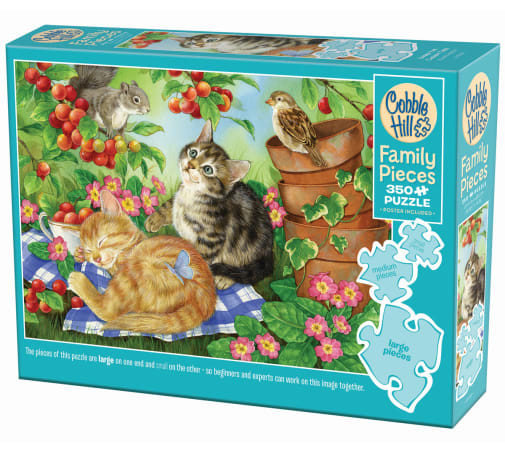Make an adorable discovery when you peek under the cherry tree! This 350-piece puzzle has three different piece sizes all in the same puzzle, making it ideal for puzzlers of a variety of ages and skill levels to all participate together. The pieces are large on one end and small on the other, with medium-sized pieces in the middle. While ideal for families, this puzzle could easily be enjoyed as a solo project too. Measures 26.6” x 19.25” when completed. Poster included for reference.
Cobble Hill Under the Cherry Tree Puzzle (Family 350 piece)
SKU
046922
Grade 2-AD
These icons are designed to help you quickly understand and learn important information about our products.
Teaching Method
Traditional
Teacher-centered curriculum commonly used in classrooms that may include a text, teacher manual, tests, etc.
Charlotte Mason
A methodology based on the work of a 19th century educator who maintained that children learn best from literature (Living Books), not textbooks.
Classical
A methodology based on the Latin Trivium (three stages of learning), including the grammar stage (memorization and facts), logic stage (critical thinking), and rhetoric stage (developing/defending ideas).
Unit Study
A thematic or topical approach centered around one topic that integrates multiple subject areas.
Montessori (Discovery)
A methodology based on the work of a 20th century educator that emphasizes student and sensory-driven discovery learning and real-life applications.
Other
Other methodologies
Religious Content
Secular
Contains content contrary to common Christian beliefs (i.e. evolution).
Neutral
Avoids religious or theoretical topics or presents multiple viewpoints without preference.
Christian/Religious
Faith-based or including instructional religious content.
Learning Modality
Auditory
Learns through listening, talking out loud or reading out loud.
Visual
Learns through seeing, prefers written instructions and visual materials.
Kinesthetic/Tactile (Hands-On)
Learns through moving, doing and touching.
Multi-Sensory
Curriculum that employ a variety of activities/components.
Presentation
Sequential
Curriculum progresses through well-defined learning objectives. Emphasizes mastery before moving to the next topic.
Spiral
Topics and concepts are repeated from level to level, adding more depth at each pass and connecting with review.
Conceptual/Topical
Focus is on the “why,” often with a unifying concept as well as specific skills; coverage may be broader.
Teacher Involvement
Low Teacher Involvement
Student-led materials; parent acts as a facilitator.
Medium Teacher Involvement
A mix of teacher-led time and independent student work.
High Teacher Involvement
Teacher-led lessons; may utilize discussions, hands-on activities and working together.
Additional Materials Required
No other materials needed
Everything you need is included.
Other Materials Required
There are additional required resources that are a separate purchase.
Other Materials Optional
There are additional resources mentioned or recommended but are not absolutely necessary.
Consumable
Consumable
Designed to be written in; not reusable.
Non-Consumable
Not designed to be written in; reusable.
Our Price
$17.99 $17.99 $13.95
Rainbow Savings: $4.04
Product Overview
- Three different sizes of pieces all in one puzzle make this an ideal family project!
- Assemble a scene of adorable kittens curled up under the cherry tree!
- Poster included for reference
- Completed 350-piece puzzle measures 26.6” x 19.25”
Description
Publisher's Description of Cobble Hill Under the Cherry Tree Puzzle (Family 350 piece)
Under the Cherr Tree you'll make a sweet discovery! Cute little kittens have found a resting place, while the birds and squirrels have come to join them. It's a cozy spot on the grass and we're sure you'll enjoy spending with them too.
Category Description for Cobble Hill 350-Piece Family Puzzles
Assemble your family for some bonding time! These unique 350-piece family puzzles from Cobble Hill have large, medium, and small pieces all in the same puzzle so that children and adults can work together at the same time. Scenes are cut into large pieces on one half of the puzzle and gradate to smaller pieces on the other half.
Details
| Product Format: | Other |
|---|---|
| Grades: | 2-AD |
| Brand: | Cobble Hill Puzzle Company |
| EAN/UPC: | 625012470391 |
| Length in Inches: | 8.375 |
| Width in Inches: | 11.375 |
| Height in Inches: | 2 |
| Weight in Pounds: | 1.5 |
Videos
Reviews

